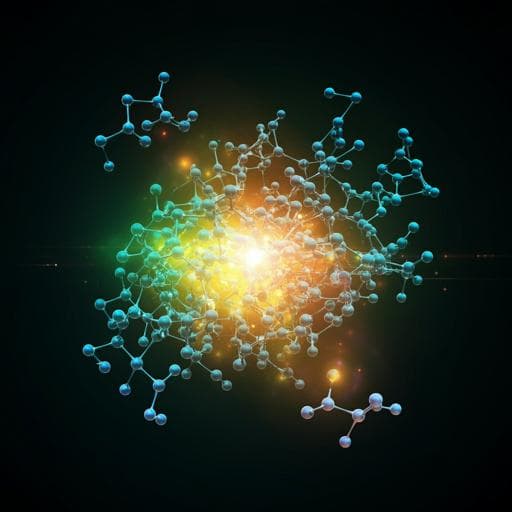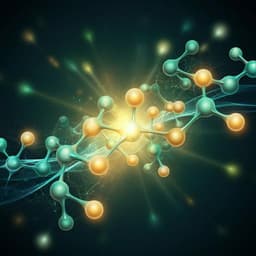
Chemistry
Giant dimeric donors for all-giant-oligomer organic solar cells with efficiency over 16% and superior photostability
C. Wang, X. Ma, et al.
Explore groundbreaking research by Caixuan Wang and colleagues, which introduces innovative giant oligomeric donors designed to enhance organic solar cells' efficiency and stability. This study demonstrates all-giant-oligomer OSCs achieving over 16% efficiency and exceptional photostability, paving the way for new advancements in solar technology.
~3 min • Beginner • English
Introduction
The study targets a key challenge in organic solar cells (OSCs): replacing batch-variable polymer donors with structurally defined oligomeric donors to enable reproducible, stable, and efficient devices. Prior work on giant oligomeric acceptors (e.g., giant dimeric and star-shaped trimeric acceptors) achieved high efficiencies and stability, but still relied on polymer donors, limiting reproducibility. The authors hypothesize that designing giant oligomeric donors using tailored linkers to control homo-molecular interactions and thermal-driven assembly can yield all-giant-oligomer OSCs (AGO-OSCs) with high efficiency and superior stability. They identify linker chemistry and linkage positions as critical yet underdeveloped design parameters. Building on successful small-molecule donor and giant acceptor design, they synthesize two isomeric rhodanine-based linkers (para- and meta-connected) to construct giant dimeric donors G-Dimer-D1 and G-Dimer-D2, aiming to modulate dihedral angle, molecular interactions, assembly behavior, and ultimately device morphology and performance. The work seeks to demonstrate efficient AGO-OSCs and provide general design principles for giant donors.
Literature Review
The authors situate their work within efforts to improve OSC performance and stability through material design. Small molecules offer defined structures and good assembly but can suffer from over-aggregation and limited long-term stability, while polymers offer potential thermal stability but suffer from batch-to-batch variability and chain entanglement. Recent advances with giant oligomeric acceptors (giant dimeric and star-shaped trimeric acceptors) delivered high efficiencies and stability using linker engineering, validated by multiple groups. However, donor-side oligomerization remains scarce: previously reported donor dimers (porphyrins, BODIPY) performed poorly in binary devices, and principles for efficient giant dimeric donors are largely undeveloped. Prior findings emphasize the importance of linker type and linkage position in controlling conformation, aggregation, and device performance for dimerized acceptors; the present work extends this rationale to donor design by engineering isomeric linkers to balance homo-molecular interactions and thermal-driven assembly.
Methodology
Design and synthesis: Two isomeric rhodanine-based benzyl linkers (para- and meta-substituted) were synthesized and used to dimerize an efficient small-molecule donor (MPhS-C6) via a modular approach employing dimerized end-capped units and Knoevenagel/condensation steps (50–70% yields). A flexible methylene spacer was inserted between the linked benzene and conjugated backbone to tune homo- versus hetero-interactions. A third variant (G-Dimer-D3) shortened end-capped alkyl chains (n-hexyl to n-butyl) to further adjust assembly.
Characterization of molecular properties: DFT (B3LYP/6-31G(d,p), alkyls simplified to methyl) was used to evaluate optimized conformations and frontier orbital distributions. UV–vis absorption spectra were measured in solution and films; cyclic voltammetry determined HOMO levels. Differential scanning calorimetry (DSC) assessed melting point (Tm), melting enthalpy (ΔHm), crystallization temperature (Tc), and glass transition (Tg) or low-temperature crystallization. Temperature-dependent absorption and deviation metric fitting provided Tg or low-temperature crystallization onset (TLTC) and the slope above Tg (KDMT) as a proxy for thermal-driven assembly capability.
Film assembly and morphology: In-situ UV–vis–NIR spectroscopy during spin-coating (5 ms resolution) tracked donor 0–0 absorbance and acceptor red-shift to probe aggregation kinetics and sequence. Thermal annealing (TA) effects were monitored by in-situ spectra and microscopy. Morphology and crystallinity were characterized by TEM, AFM, and GIWAXS (2D patterns, (010) π–π peak, coherence crystalline length CCL, d-spacings) in pristine and blend films before/after TA.
Device fabrication: Devices used ITO/PEDOT:PSS/active layer/PFN-Br/Ag. Donor:acceptor ratio 1.9:1 (CF solvent, total 15 mg mL−1; MPhS-C6/Y6 16 mg mL−1); 0.2 vol% DIO added 30 min prior to spin-coating. Active layers were spin-coated (1400 rpm, 30 s), then TA optimized (AGO 125 °C; ASM 115 °C; G-Dimer-D3 at 130 °C). PFN-Br (0.5 mg mL−1 in MeOH) was spin-coated as cathode interlayer; Ag (~160 nm) was thermally evaporated. J–V measurements used AM 1.5G (100 mW cm−2); EQE measured with a spectral response system. Device areas were 4 mm² (confirmed with 2.56 mm² mask).
Charge/optical measurements: SCLC in hole-only (ITO/PEDOT:PSS/active/MoO3/Ag) and electron-only (ITO/ZnO/active/PNDIT-F3N/Ag) structures yielded mobilities via Mott–Gurney fits. Transient photocurrent (TPC) used a 488 nm laser (~30 ns pulses) and oscilloscope readout. Photocurrent density versus effective voltage determined exciton dissociation (Pdiss) and charge collection (Pcoll). FTPS-EQE quantified Urbach energy (Eu) of charge-transfer states; EQE_EL measured radiative efficiency and non-radiative voltage loss (ΔVnr = −kBT ln EQE_EL). Contact angles (Owens–Wendt) provided surface energies and solubility parameters for interaction analysis.
Key Findings
- Linker isomerism controls interaction and assembly: G-Dimer-D2 (meta-linked) exhibits much lower homo-molecular interaction and higher thermal-driven assembly capability than G-Dimer-D1 (para-linked).
- Thermal properties (DSC):
• G-Dimer-D1: Tm 264.8 °C; ΔHm 34.8 J g−1; Tc 197.3 °C; weak exotherm at 221.8 °C (crystal modification).
• G-Dimer-D2: Tm 176.3 °C; ΔHm 19.3 J g−1; Tc 124.0 °C.
• MPhS-C6: Tc 132.5 °C; intermediate Tm and ΔHm.
• Assembly metrics: TLTC (D1) 96.2 °C; Tg,s (D2) 75.1 °C; Tg,s (MPhS-C6) 83.5 °C. KDMT: D2 0.053 (highest), D1 0.0038 (lowest).
- Pristine-film packing (GIWAXS): G-Dimer-D2 shows dominant face-on orientation with OOP (010) π–π peak and IP (100) peak, strengthened after TA. As-cast (010) CCL: D2 16.4 Å, D1 25.1 Å, MPhS-C6 31.9 Å. TA boosts CCL by 1.79× (D2) and 1.59× (MPhS-C6), but negligibly for D1.
- Blend film formation (in-situ spectroscopy):
• G-Dimer-D1/DY: sequential aggregation with donor segregating first (stronger homo-interaction, lower solubility).
• G-Dimer-D2/DY and MPhS-C6/Y6: simultaneous donor/acceptor aggregation. Assembly time: D2/DY ~180 ms vs MPhS-C6/Y6 ~80 ms (slower due to doubled MW).
• As-cast G-Dimer-D2/DY: loosest initial packing (dπ–π = 3.67 Å), shortest OOP (010) CCL 23.1 Å, and smallest energetic disorder (Ea ≈ 21.8 meV).
• TA effects: D2/DY OOP (010) CCL increases from 23.1 Å to 35.6 Å; dπ–π shrinks to 3.59 Å. MPhS-C6/Y6 and D1/DY show smaller CCL increases (mainly IP for MPhS-C6/Y6; minimal for D1/DY).
• Energetic disorder (Eu) changes upon TA: ΔEu ≈ 0.5 meV (D2/DY), ≈ 1.4 meV (MPhS-C6/Y6); D2/DY remains the smallest disorder among blends.
- Device performance (optimized, ITO/PEDOT:PSS/active/PFN-Br/Ag):
• G-Dimer-D2/DY (125 °C TA): PCE 15.70%, Voc 0.858 V, Jsc 24.40 mA cm−2, FF 75.00%.
• G-Dimer-D3/DY (n-butyl end-caps, 130 °C TA): PCE 16.05%, Voc 0.859 V, Jsc 24.36 mA cm−2, FF 76.64%.
• G-Dimer-D1/DY (125 °C TA): PCE 14.12%, Voc 0.858 V, Jsc 23.47 mA cm−2, FF 70.06%.
• MPhS-C6/Y6 (115 °C TA): PCE 15.31%, Voc 0.830 V, Jsc 24.34 mA cm−2, FF 75.74%.
• G-Dimer-D2/Y6 (125 °C TA): PCE 15.28%, Voc 0.844 V, Jsc 24.11 mA cm−2, FF 75.14%.
- Charge transport and recombination:
• Mobilities (cm2 V−1 s−1): hole μh = 0.6×10−3 (D1/DY), 1.17×10−3 (D2/DY), 1.70×10−3 (MPhS-C6/Y6); electron μe = 0.19×10−3, 0.50×10−3, 0.77×10−3, respectively.
• Trap-assisted recombination suppression: ideality factor n = 1.06 (D2/DY) vs 1.39 (D1/DY) and 1.31 (MPhS-C6/Y6).
• Charge utilization: Pdiss/Pcoll = 97.75%/84.62% (D2/DY); 96.02%/79.81% (D1/DY); 96.67%/83.61% (MPhS-C6/Y6). For D2/Y6: 96.76%/84.78%.
• TPC lifetimes: 24.2 ns (D2/DY), 34.6 ns (MPhS-C6/Y6), 40.6 ns (D1/DY); D2/Y6 24.7 ns.
- Non-radiative voltage loss:
• EQE_EL-derived ΔVnr: 0.214 V (D2/DY), 0.209 V (D2/Y6), 0.227 V (D1/DY), 0.241 V (MPhS-C6/Y6), 0.242 V (MPhS-C6/DY). G-Dimer-based devices show reduced ΔVnr during TA relative to ASM controls.
- Stability:
• Light-soaking (N2, 1 sun): AGO-OSCs show alleviated burn-in; G-Dimer-D2 retains ~86% initial PCE; extrapolated T80 ≈ 9656 h.
• Light-induced changes after 10 h: ΔVnr increases 113 meV (D1/DY) vs 9 meV (D2/DY); corresponding Eu increases 4.0 meV vs 0.6 meV. GIWAXS shows ordered regions stable; degradation originates in amorphous D/A regions.
• Thermodynamic driving force: ΔGs = (Tm − Tc)/Tm × ΔHm ≈ −3.57 J g−1 (D2/DY) vs −8.02 J g−1 (D1/DY). Lower |ΔGs| with longer CCL in D2/DY correlates with more thermodynamically stable morphology and reduced burn-in.
Discussion
Engineering linker isomerism in giant dimeric donors modulates the balance between homo-molecular interactions and thermal-driven assembly, which governs film formation kinetics, crystalline ordering, energetic disorder, and device performance. The meta-linked G-Dimer-D2 exhibits weak homo-interactions yet strong thermal-driven assembly, enabling simultaneous donor–acceptor aggregation during film formation, slower assembly due to higher molecular weight, and efficient ordering upon thermal annealing. This pathway produces blends with optimized π–π stacking (increased OOP CCL, reduced d-spacing), minimal increases in energetic disorder upon TA, and improved charge transport with suppressed trap-assisted recombination. Consequently, G-Dimer-D2/DY devices achieve superior Jsc, FF, and Voc compared with the para-linked G-Dimer-D1 and the ASM control, aided by lower non-radiative voltage losses. Morphological stability analysis links reduced burn-in to a smaller thermodynamic crystallization driving force (ΔGs) and longer CCLs in D2/DY, yielding an optimized morphology closer to equilibrium. Burn-in and ΔVnr increases are traced to disordered D/A mixed regions rather than ordered crystalline domains, explaining the markedly improved photostability in AGO-OSCs. These findings validate the hypothesis that tailored linker design in giant donors can deliver efficient, stable all-oligomer devices with fully defined chemical structures.
Conclusion
The work introduces a design strategy for giant dimeric donors using isomeric rhodanine-based linkers to control molecular interactions and thermal-driven assembly. The meta-linked G-Dimer-D2, paired with a giant dimeric acceptor (DY), enables the first all-giant-oligomer OSCs with high efficiency (PCE 15.70%) and exceptional photostability (extrapolated T80 ≈ 9656 h), further improved to 16.05% PCE by shortening donor end-capped alkyl chains (G-Dimer-D3). Mechanistically, D2’s combination of weak homo-interactions and strong thermal-driven assembly yields ordered packing with low energetic disorder, efficient charge extraction, and reduced non-radiative voltage loss. Thermodynamically, a smaller |ΔGs| and longer CCL lead to more stable morphologies and alleviated burn-in. The study establishes generalizable principles for giant donor design and demonstrates AGO-OSCs as promising candidates for reproducible, high-efficiency, and stable organic photovoltaics. Future research should expand all-oligomer donor–acceptor libraries, refine linker chemistries and side-chain engineering, and translate these materials to scalable processing and large-area devices while probing operational stability in diverse environments.
Limitations
The authors note that research on all-oligomer systems remains limited and there is substantial room to further improve PCE. While photostability is strong, the reported stability tests were performed under nitrogen atmosphere; broader environmental and operational conditions were not detailed. Design principles for giant donors, though advanced here, will benefit from further systematic studies across linker types, linkage positions, and side-chain variants.
Related Publications
Explore these studies to deepen your understanding of the subject.







